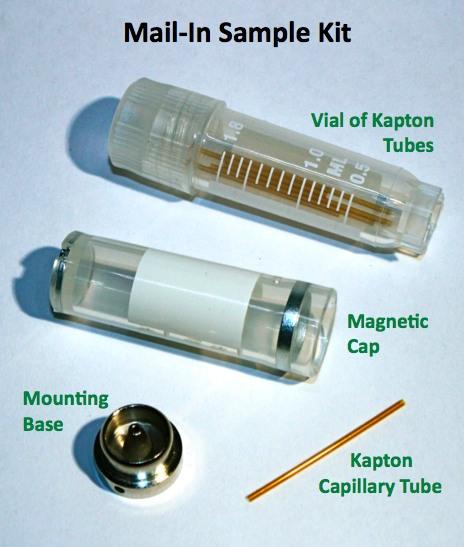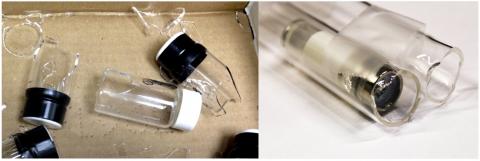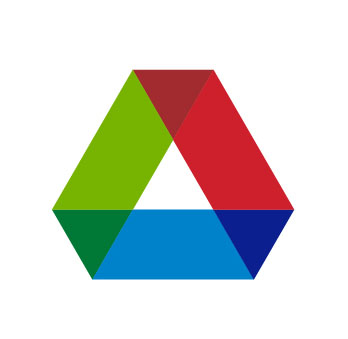Currently we are updating the 11-BM mail-in systems and the links found below will not work. Please contact beamline staff directly with questions.
For 11-ID-B and 17-BM mail-in users, instructions can be found here .
General Notes
Carefully read and follow these instructions to ensure a successful mail-in experiment. Contact 11-BM staff with questions at anytime.
Please note the APS run Schedule and proposal Calendar dates.
Samples arriving during or just a shutdown will be saved and run in the following cycle. Contact staff for details.
Proprietary industrial users should consult additional instructions about performing experiments at the APS.
Please note additional important APS safety guidelines. Although many apply only to on-site users, Mail-In users should review notes for Experiment Hazard Classes and restrictions on the Shipping of Samples.
Submit a Proposal
To obtain experimental time at 11-BM, all users must submit a General User Proposal (GUP). Proposals for the rapid access mail-in service are limited to 1 shift (~ 8 hours or 8 samples) per proposal, but may be submitted at anytime. Standard proposals must be submitted prior to the run cycle deadlines (three times per year). Check the GUP calendar for exact dates.
Safety Notice
The mail-in service cannot accept any of the following sample types:
- Biohazards
- Human-Derived Materials
- Radioactive Materials
- Non-Sterilized Regulated Soils
- Explosives or Unstable Materials
Note: we are also unable to accept materials that possesses more than one of the following hazards: flammable, corrosive or oxidizer.
RCRA regulated metals (the heavy metals Ag, As, Ba, Cd, Cr, Hg, Pb and Se) can be accepted, but samples containing them must be identified (see "Register Sample Base Numbers" below).
Additionally, all registered samples shipped to the APS must qualify for small quantity exceptions under U.S. Dept. of Transportation (DOT) regulations (CFR Title 49 § 173.4). Full safety details and definitions are available on the 11-BM Sample Hazard webpage.
Please take special care to ensure that samples potentially hazardous to beamline staff (Nano, Toxic, Carcinogenic, Flammable, etc) are securely contained and permanently sealed in the Kapton tubes.
Inquire about special sized sample mounting bases and double nesting Kapton tubes if your permissible samples are particularly hazardous or air sensitive.
Request Sample Base Kits
Rapid access proposals for the mail-in service are normally reviewed within 1 week. You will receive email notification if your proposal is accepted. This email will contain instructions (and web links) describing how to request sample base fits for your mail-in experiment. Follow the email links, or navigate to:
http://11bm.xray.aps.anl.gov/user.php?step=1
At the above link, users enter a GUP proposal number, the associated e-mail address, and requested number of sample base kits. Argonne or APS based users may also specify that sample bases be held on-site (not mailed) for local pickup. Note: rapid access proposals are limited to 1 shift (~ 8 hours or 8 samples) per proposal.
Once bases are requested, a confirmation email message will be sent. Please double check that the user name(s) and shipping address (listed in the email message) are correct. You MUST click on the link embedded in the email to confirm your request. Bases will not be sent without your confirmation.

Receive Sample Base Package
Sample base kits are shipped to your confirmed address. In this package, you will find your requested mail-in sample base kit(s) and a pre-printed return shipping label. For each requested sample base, the package contains the following: one sample mounting base, one magnetic cap, and Kapton sample capillary tubes (inside a plastic vial). Additional Kapton tubes are provided for your convenience. Requests are normally processed within a few days, and packages are sent via the US Mail.
Each part of the sample base kit is described below and shown in the image on the right.
Mounting Base: Holds one sample capillary tube and is integrated with the robotic arm used for automated data collection. The unique 10 digit barcode (e.g. ANL0AA1234) printed on the side, also encoded in a 2D barcode on the bottom, tracks the sample at all steps of our mail-in service. Note: The barcode number is required when registering each sample online.
Do NOT return any materials to the APS until your samples have been registered, verified, and approved by beamline staff.
Magnetic Cap: A magnetic ring secures caps on mounting bases, and provides some protection for sample capillary tubes during shipment. Please avoid writing on the caps, as they are re-used and cannot be used to identify your sample. Note: all samples must fit completely inside the caps when placed on mounting bases; longer samples may be destroyed by the 11-BM robotic sample loader.
Capillary Tubes: The supplied Kapton tubes have an inner diameter of 0.80 mm, and an outer diameter that fits snugly inside 11-BM mounting bases. Kapton is stable over a wide temperature range and adds a negligible contribution to the diffraction scan background. Note: All sample powders must be fully contained and secured within these capillary tubes.
Prepare Sample Capillaries
Sample preparation is critical and can dramatically impact the quality of your collected data.
See the 11-BM Sample Preparation page for details.
If in doubt - please contact 11-BM staff with any questions on sample preparation before shipping your sample(s).
Register Sample Base Numbers
You must register and receive email approval from 11-BM staff BEFORE mailing any samples to the APS.
Register your sample(s) using the provided email links or on the 11-BM web page at:
http://11bm.xray.aps.anl.gov/user.php?step=2
For each sample, provide a complete chemical name, a chemical formula that specifies all elements present in the material by the one or two-letter elemental symbol, and an optional sample ID for your records. Do not use non-element symbols to stand for classes of elements (RE for rare-earth, etc). Compositions may be symbolic or approximate [e.g. Na(x)Li(1-x)O]. Also specify the appropriate hazard(s) information.
Check all the hazard boxes that apply. Eight metals (Ag, As, Ba, Cd, Cr, Hg, Pb and Se) are regulated as "heavy metals." If your sample contains any of these, please note that by selecting "Other, specify:" in addition to the other hazards (they would be "Toxic" as well, for example) and note "RCRA Metals" in the text-entry box next to the "Other, specify:" check-box.
After submitting this information online, you will be sent an email to which you MUST reply and electronically verify the provided information. This "e-signature" is necessary to comply with APS and DOE safety regulations.
You will receive a confirmation email when your sample registration is reviewed and approved; only then may you send samples to the APS (see shipping section below). The provided sample information (once approved) is used to generate an Experimental Safety Approval Form (ESAF) for your experiment. For 11-BM mail-in users, an ESAF is automatically created, submitted and posted on your behalf by beamline staff.
Note: It is important that samples are registered, verified, and approved before shipment to the APS. Unregistered samples received at 11-BM may be destroyed immediately. Repeat offenders may lose mail-in access to 11-BM.
Select Scan Parameters
Mail-in users select scan parameters for their samples during sample registration (see above). Scan types are selected by the pull-down menu on the registration webpage. Most users select a standard (~1 hour) scan at room temperature (Ambient) or low temperature (100 K). Alternatively, after first providing sample information, users may select "Other" to request custom scan parameters for one or more samples on a subsequent webpage (this page appears only after clicking on the "Register Sample Info" button to proceed).
Custom scan options include select temperatures between 100 K (-175 C) and 400 K (+125 C), and a choice of more specialized scan parameters (2θ range, step size, etc). The total estimated experiment time is tracked and limited to 1 shift (8 hours) per rapid access mail-in proposal. Note: we cannot guarantee the run order of mail-in samples - they will be run in the most efficient sequence for data collection, not necessarily the order you specify.

Send Samples to Argonne
Users are responsible for shipping samples to 11-BM at Argonne in full compliance with DOT rules and regulations (see Safety Notice above). You may use the US Mail or a commercial shipping company (FedEx, UPS, DHL, etc). We recommend protecting samples in bubble wrap (provided) or some other padding during shipment.
GLASS Regulation: The use of glass vials, ampoules or other containers for shipping 11-BM samples to the APS is now prohibited. (excluding nested sample quartz capillaries). Instead, simply use bubble wrap or plastic containers. Most of the time, glass containers are broken on arrival at the APS, which is dangerous for beamline staff and does nothing to protect your samples.
Email notification will be sent when samples are received at the beamline. Note: we do not track sample base kits sent out, and cannot help track samples shipped back to the APS. Also, do not add a signature requirement for delivery of your package; these samples may be delayed or returned by the laboratory receiving office.
Samples should be shipped to this address:
11-BM Staff 9700 S. Cass Ave, Bldg. 433/D001 Argonne National Laboratory Lemont, IL 60439-4856
International users shipping from outside the U.S. are responsible for all regulations covering international shipment of chemicals. Ensure paperwork required for entry of samples to the U.S. is done in advance and is filed with the shipment. Please note if samples are assigned a value, US Customs may request duty payment. We cannot assist with international shipping paperwork or provide documentation or payment for samples.
Collect Diffraction Data
Email notification will be sent to users once data have been collected on your sample(s). Our goal is to collect data on registered samples within ~3 weeks of receipt at 11-BM. Often data is available much sooner, sometimes within just a few days, but depending on beamline scheduling and the APS operations calendar there may be an unavoidable delay. Once collected, beamline staff reviews each data set and may include comments in the notification email(s) when appropriate.
Data may be obtained by following the provided email links or on the 11-BM web page at:
http://11bm.xray.aps.anl.gov/user.php?step=4
Users may request data be emailed directly (sent as an archived zip file), or uploaded to the APS Data Management system/GLOBUS.
Additional information about 11-BM data and file formats is available on the website.
Publish Results
The free mail-in powder diffraction service for non-proprietary research at 11-BM is made possible by funding from the U. S. Department of Energy. By reporting publications that include 11-BM data, you demonstrate the value of this beamline to your research and help ensure that funding for the program is continued.
Proprietary users who do *not* intend to publish their data should consult the APS User Office for help setting up appropriate Proprietary User Agreements.
More information about publishing (and published) 11-BM data is available on the website.
Please report all citations to beamline staff. We will also periodically inquire on the status of unreported mail-in user data via automated emails.
It is APS policy is that publications using data collected at the APS contain the following acknowledgement:
Use of the Advanced Photon Source at Argonne National Laboratory was supported by the U. S. Department of Energy, Office of Science, Office of Basic Energy Sciences, under Contract No. DE-AC02-06CH11357.
Thanking beamline staff is always welcome, but co-authorships are only expected where we have been involved in experiment design or data analysis.
Dispose of Samples
By default, all mail-in samples sent to 11-BM will be saved for a minimum of two weeks after data collection before being disposed.
Under special circumstances, samples may be returned if requested in advance. All requests for sample return must be made via the 11-BM user web pages at the time of sample registration.
http://11bm.xray.aps.anl.gov/user.php?step=3
Users requesting sample return should arrange for payment of shiping costs (e.g. APS cost code, FedEx #, etc) and MSDS datasheets are required for all compositions. Requests will be processed when beamline operations allow; no specific delivery dates can be guaranteed. Note: sample return is time consuming and could impact the number of accommodated samples; please request return only where samples are of significant value.
international Users: Due to the complexities of overseas sample shipping, we regret that samples cannot be shipped to addresses outside of the U.S. If needed, please find a U.S. based collaborator to assist with international sample return.
Questions / Comments
Thank you for reading all the way to the end, and good luck with your mail-in synchrotron powder diffraction experiment at 11-BM.
Please feel free to contact 11-BM beamline staff at anytime ([email protected]) with your questions, comments, or suggestions about how we can improve this service.

